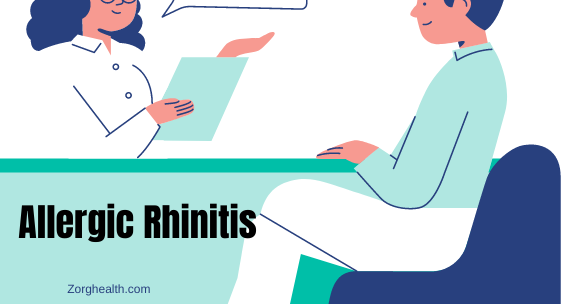Allergic rhinitis (AR) is the disorder of upper respiratory passage in which there is inflammation and the hyper response of nasal airway characterized by symptoms such as itching nose, nasal discharge, sneezing, and nasal obstruction which can sometimes be severe and accompanied by asthma. Allergic rhinitis is one of the types of rhinitis which is triggered after exposure to an allergen mostly in spring, summer, or late summer and autumn due to more pollen in the air.

Allergic rhinitis is an Ig E(immunoglobulin E) mediated response. It can be early or late.
Early Allergic Reaction
o Happens immediately within 15 – 30 minutes after exposure
o Happens due to mast cell degranulation and release of histamine
Late Allergic Reaction
o Happens late around 6-12 hours after exposure
o Mediated via Eosinophils, Basophils.
o These mediators cause epithelial damage, increased mucus secretion.
There are typically 4 types of defensive immune responses or reactions by our body which are considered as protective immune responses but unfortunately sometimes cause harm to the host.
These reactions are-
Type 1– This is immediate reaction/response & it involves Ige which leads to release of histamine and other mediators which lead to allergic rhinitis, another example of type 1 reaction is anaphylaxis
Type 2– This is kind of a cell-killing reaction and is mediated via IG G and IG M
Type 3 – In this antibody along with antigen (bound together) deposit in minute blood vessels and lead to damage e.g., serum sickness.
Type 4 – Also known as delayed hypersensitivity this reaction is mediated via T cells rather than any antibody or antigen-antibody complex. For example- poison ivy-related dermatitis.
So early allergic rhinitis is a type 1 hypersensitivity reaction which explains the immediate response when a patient comes in contact with the allergen.
Why does Allergic Rhinitis happen?
As explained earlier when your body comes in contact with something that you are allergic to for example dust mites, the type 1 hypersensitivity response leads to the release of histamine and it causes-
- Via action on smooth muscles causes spasm of airways
- Via action on H1 receptors increases nasal secretions
- Via action on sensory nerves causes itching
- Via dilatation of smaller blood vessels causes stuffiness of the nose
Symptoms of Allergic Rhinitis
- Running nose
- Itching in the nose
- Excessive sneezing
- Itching in eyes
- Watering from eyes
- Cough
- Postnasal drip (repeated throat clearing)
- Headaches which are frequent
- Skin dryness, itching, hives (skin rashes)
- Tiredness /sleepiness
And these symptoms can sometimes be so severe that patients may need hospital admission.
Types of allergic rhinitis
Allergic rhinitis is further divided into seasonal and perennial. Seasonal occurs mostly during spring where there are pollens outdoor or during rainfall. Perennial allergies on the other hand can happen any time around the year and are mainly due to indoor allergens.
Risk factors attributing to the development of allergic rhinitis
Although anyone can be allergic to anything or might develop it later on but some well-known risk factors can make someone more likely to develop an allergy.
- History of some allergy in the family
- Tobacco smoking
- Environmental chemical exposure e.g., factory or industrial fumes
- Extreme cold temperature or extreme humid temperature
- Dusty surrounding or area near chemical factories or industries
- Pollution.
- Fire smoke, fumes.
- Strong smells like perfumes, cologne
- Pets, animal dander.
- Mold
Other types of rhinitis are–
- Infectious- bacterial fungal or viral
- Nonallergic and non-infectious- like vasomotor rhinitis which is non-inflammatory, there happens sensorineural hyperresponsiveness which leads to the dilation of blood vessels which results in swelling, congestion, and excessive nasal discharge (rhinorrhea), or else it can be a local allergic reaction to the nose
- Nonallergic rhinitis with eosinophilia syndrome (NARES).
- Chronic hypertrophic rhinitis with or without polyps.
There are other less common forms as well like–
- Occupational rhinitis- which further can be allergic or non-allergic
- Hormonal- associated or resulting due to pregnancy, lactation, OCP (oral contraceptive pills), or thyroid deficiency
- Drug-induced like in some people who take aspirin
- Food induced
- Cold air induced also known as Skier’s nose
- Atrophic (age-related)
Conditions that can mimic allergic rhinitis
Allergic rhinitis is called hay fever when the allergic response is in reaction to a specific allergen, for example, seasonal hay fever is in response to tree pollen, grasses, weeds, etc. Otherwise, the common allergic response is in reaction to a common airborne allergen in our surroundings which are mold, animal dander, dust mites, cockroaches, feathers, etc.
Allergic rhinitis has a very high prevalence and people suffering from it have impaired quality of life, difficulty in sleeping, difficulty in learning and doing daily occupational and household work, resulting in work or school absence. Other problems which can result due to allergic rhinitis are cough, asthma, sinusitis, otitis media, nasal polyps.
How to know if you have Allergic rhinitis or cold
Minor or starting stage of AR can be diagnosed if you are suffering from the symptoms mentioned earlier and if you can relate the trigger as some allergen exposure e.g., Excessive sneezing, watering nose and eyes while cleaning the house without covering the nose.
Difference between allergy and common cold!
Both cold and allergic rhinitis have similar symptoms. One of the ways to tell the difference is that in cold you are more likely to feel tired or fatigued. In cold one has more body aches and pains with a sore throat. Fever with the symptom of allergy is more likely to be cold, while if you feel excessive sneezing or itching in the nose or eyes then it’s more likely to be allergic rhinitis.
For more confirmation you can visit an ENT doctor after examination they can go for SPT (skin prick test) to confirm and find possible allergens. The doctor will check sensitivity against several commonly found allergens and how the body reacts to each one. Other tests which can be advised are the radioallergosorbent test (RAST), a blood test that measures antibodies (IgE) against a particular antigen.
During the COVID-19 pandemic, one more threatening doubt which spread very quickly and filled everyone’s mind with fear was mucormycosis or black fungus.
How is Allergic rhinitis treated?
Your doctor may prescribe any of the following drugs to reduce allergic expression and for long-term relief.
- Antihistamines – as the name suggests they stop production and work against histamine. E.g., fexofenadine, diphenhydramine, desloratadine, loratadine, levocetirizine, cetirizine.
- Decongestant– to give you relief from a stuffy nose, but they are usually prescribed for short term only from 3 days to a maximum of 7 days as their long-term use can be harmful to the nose. E.g., oxymetazoline, pseudoephedrine, phenylephrine, cetirizine with pseudoephedrine. Along with them, nasal saline preparations are also given.
- Nasal sprays– some steroid sprays may be required for long-term relief.
- Desensitization or immunotherapy. Also known as allergy shots. This is a time-taking procedure in which your body is slowly desensitized for particular antigens (confirmed via SPT or RAST) and is done in two phases, build-up, and maintenance phase. This treatment may go for up to 5 years.
- Another type of immunotherapy Is sublingual immunotherapy (SLIT). For those who don’t want multiple allergy shots SLIT is advised. SLIT is keeping a tablet under your tongue and this tablet contains a mixture of allergens like grass, tree pollen, ragweed, animal dander, and dust mites. But is available for only a few allergens and it is advised to take this treatment only after a doctor’s prescription.
Home remedies for allergic rhinitis
In simple words, allergy is some reaction to an environmental allergen to an extent that it is bothering you while others around you are unaffected. The best measure is avoidance of the allergen or at least minimize the exposure. The other things which you can try are-
- Air conditioners– as they continuously clean the room air, they reduce the number of possible allergens in the room, also they act as dehumidifiers that limit the growth of mold and mildew.
- High-efficiency particulate air (HEPA) filter– these are very efficient filters for people living near construction sites or in highly polluted cities.
- Saline nose wash– both adults and children can use saline drops or irrigation to get some relief from symptoms of allergic rhinitis.
- Keep hygiene– Clean surroundings are less likely to give you allergies, it is advised to keep your linen separate and clean especially mats and carpets.
- Humidifiers are advised for people with hot dry and windy surroundings.
- Fruits– papaya and pineapple are known to have natural bromelain which improves breathing in allergy people, but before consuming make sure you are not allergic to these fruits.
- Vegetables– Broccoli, cauliflower, etc naturally contain “quercetin” which balances histamine release and controls allergy.
- Citrus fruits and vitamin C– their daily consumption helps in reducing histamine levels.
- Honey– one theory is that if you consume local honey then it will reduce your tendency to develop an allergy to pollen that the bees in that area used to make honey.
- Pre-probiotics– few studies have shown their effectiveness in improving symptoms of allergy. E.g., curd, Yakult, or over-the-counter (OTC) medicines.
- Essential oils– frankincense oil benefits patients of perennial allergic rhinitis, it can be applied to the body after diluting or can be used with a diffuser for inhalation. Eucalyptus oil apart from giving relief from nasal congestion it helps in reducing microbial load when used during washing clothes.
Self-care and cleaning tips to avoid allergic rhinitis
Self-care– as it’s not possible to completely avoid allergens there are a few tips and practices which can minimize exposure to them.
Tips to minimize exposure to pollen or molds:
- Keep your doors and windows closed during the pollen season
- Stay indoors as much as possible on dry, windy days
- In the coastal area, one can use a dehumidifier to reduce humidity
To minimize exposure to dust mites:
- You can use allergy-proof covers on bed sheets and pillows
- It is advised to wash bed sheets and blankets in water heated to at least 130 degrees Fahrenheit to kill dust mites
- Vacuuming carpets weekly will help in reducing allergen exposure and will be more effective when combined with a small-particle or HEPA filter
- If not needed don’t use carpets in bedrooms
To minimize exposure to cockroaches:
- You should seal or block all cracks and crevices from where cockroaches enter
- Change or fix leaking faucets and pipes in the kitchen
- Wash dishes and empty garbage daily
- Don’t leave food crumbs on counters and floors
- All food items should be stored in sealed containers
- Pest control is required if all these measures fail
To minimize exposure to pet dander:
- When possible separate yourself from pets and don’t allow them into your bedroom, pets should get frequent baths at least weekly
Alternate measures for Allergic Rhinitis
Yoga practices– yoga means balance and practicing yoga may help in keeping chemical composition in the body in balance
Jalaneti kriya (nasal cleansing). Proven practice to keep respiratory problems away and keep nose healthy and clean.
Acupuncture
Why should you be concerned about allergic rhinitis?
Although mild allergic rhinitis can be handled with home remedies or some OTC medicines, neglected or severe cases can develop complication like-
- Asthma
- Ear infection
- Sinus infection or polyps
- Poor quality of life, restraining from work or school
Allergic rhinitis can’t be cured over weeks or months. As explained earlier immunotherapy and other measures take years to work. Moreover, immunotherapy works against specific allergens and there is no guarantee that you will not develop an allergy to a new substance in the future. So, timely and appropriate management of allergic rhinitis is important for good quality of life and also to prevent complications.
